GOSPR 5/5/2005 5:47 PM Page i
Computer Graphics and Geometric Modeling
�
GOSPR 5/5/2005 5:47 PM Page iii
Max K. Agoston
Computer Graphics and
Geometric Modeling
Implementation and Algorithms
�
GOSPR 5/5/2005 5:47 PM Page iv
Max K. Agoston, MA, MS, PhD
Cupertino, CA 95014, USA
British Library Cataloguing in Publication Data
Agoston, Max K.
Computer graphics and geometric modeling:implementation & algorithms
1. Computer graphics 2. Geometry—Data processing 3. Computer-aided design
4. Computer graphics—Mathematics
006.6
ISBN 1852338180
I. Title
Library of Congress Cataloging-in-Publication Data
Agoston, Max K.
p. cm.
Computer graphics & geometric modeling/Max K. Agoston.
Includes bibliographical references and index.
Contents: Implementation & algorithms
ISBN 1-85233-818-0 (v. 1 : alk. paper)
1. Computer graphics. 2. Geometry—Data processing. 3. Mathematical models. 4. CAD/CAM
systems.
I. Title.
T385.A395 2004
006.6—dc22
2004049155
Apart from any fair dealing for the purposes of research or private study, or criticism or review, as per-
mitted under the Copyright, Designs and Patents Act 1988, this publication may only be reproduced, stored
or transmitted, in any form or by any means, with the prior permission in writing of the publishers, or in
the case of reprographic reproduction in accordance with the terms of licences issued by the Copyright
Licensing Agency. Enquiries concerning reproduction outside those terms should be sent to the
publishers.
ISBN 1-85233-818-0
Springer is part of Springer Science+Business Media
springeronline.com
© Springer-Verlag London Limited 2005
Printed in the United States of America
The use of registered names, trademarks, etc. in this publication does not imply, even in the absence of a
specific statement, that such names are exempt from the relevant laws and regulations and therefore free
for general use.
The publisher makes no representation, express or implied, with regard to the accuracy of the information
contained in this book and cannot accept any legal responsibility or liability for any errors or omissions
that may be made.
Typesetting: SNP Best-set Typesetter Ltd., Hong Kong
34/3830-543210 Printed on acid-free paper SPIN 10971451
�
GOSPR 5/5/2005 5:47 PM Page v
Preface
This book and [AgoM05] grew out of notes used to teach various types of computer
graphics courses over a period of about 20 years. Having retired after a lifetime of
teaching and research in mathematics and computer science, I finally had the time to
finish these books. The two books together present a comprehensive overview of com-
puter graphics as seen in the context of geometric modeling and the mathematics that
is required to understand the material. Computer graphics itself is a multifaceted
subject, but it has grown up. It is no longer necessary that a book on graphics demon-
strate the diversity of the subject with a long list of “fun” projects at the expense of
the mathematics. From movies, television, and other areas of everyday life, readers
have already seen what graphics is about and what it can do. It follows that one should
be able to present the geometric modeling aspect of the subject in a systematic
fashion. Unfortunately, the sheer amount of material that I wanted to cover meant
that it had to be divided into two parts. This book contains the practical stuff and
describes the various algorithms and implementation issues that one runs into when
writing a geometric modeling program. The book [AgoM05] provides the mathemat-
ical background for the underlying theory. Although each book can be read by itself
without reading the other, one will get the most benefit from them if they are read in
parallel.
The intended audience of this book (and the combined two volumes especially) is
quite broad. It can be used in a variety of computer graphics courses or by those who
are trying to learn about graphics and geometric modeling on their own. In particu-
lar, it is for those who are getting involved in what is referred to as computer-aided
design (CAD) or computer-aided geometric design (CAGD), but it is also for mathe-
maticians who might want to use computers to study geometry and topology. Both
modeling and rendering issues are covered, but the emphasis is on the former. The
basic prerequisites are that the reader has had an upper division data structure course,
minimally three semesters of calculus, and a course on linear algebra. An additional
course on advanced calculus and modern algebra would be ideal for some of the more
advanced topics. On the companion CD there is a geometric modeling program (GM)
that implements many of the algorithms discussed in the text and is intended to
provide a programming environment both for further experimentation and applica-
tion development. Another program (SPACE) on the CD is an application that uses
some of the more advanced geometric modeling concepts to display the intrinsic
�
GOSPR 5/5/2005 5:47 PM Page vi
vi
Preface
geometry of two- and three-dimensional manifolds. Both programs were written using
the Microsoft Visual C++ compiler (and OpenGL) and run under Microsoft Windows
98 or later. Their source code and documentation are included on the CD. The ReadMe
file on the CD lists what all is on the CD and also contains instructions for how to use
what is there.
As I began to develop this book on geometric modeling, one concern obviously
was to do a good job in presenting a thorough overview of the practical side of the
subject, that is, the algorithms and their implementation details. However, there were
two other goals that were important from the very beginning. One was to thoroughly
explain the mathematics and the other, to make the material as self-contained as pos-
sible. In other words, pretty much every technical term or concept that is used should
be defined and explained. The reason for putting all the computer graphics–related
material into one book and all the mathematics into the other rather than inter-
weaving the material was to keep the structure of the implementation of a modeling
program as clear as possible. Furthermore, by separating out the mathematics it is
easier for readers to skip those mathematical topics that they are already familiar with
and concentrate on those with which they are not. In general, though, and in partic-
ular as far as instructors using this book are concerned, the intent is that the mate-
rial in the two books be covered in parallel. This is certainly how I always taught my
courses. An added motivation for the given division was that the applied part of geo-
metric modeling was often a moving target because, largely due to improvements in
hardware (faster CPUs, more memory, more hard disk space, better display devices),
the way that one deals with it is changing and will continue to change in the future.
This is in contrast to the supporting mathematics. There may be new mathematics
relevant to computer graphics in the future but it will be a long time before the math-
ematics I do discuss will lose its relevance. A lot of it, in fact, is only now starting
to be used as hardware becomes capable of dealing with computationally expensive
algorithms.
One property that sets this book apart from others on geometric modeling is
its breadth of coverage, but there is another. The combined books, this one and
[AgoM05], differ from other books on computer graphics or geometric modeling in
an important way. Some books concentrate on implementation and basically add the
relevant mathematics by tossing in appropriate formulas or mathematical algorithms.
Others concentrate on some of the mathematical aspects. I attempt to be as compre-
hensive on both the implementation and theory side. In [AgoM05] I provide a com-
plete reference for all the relevant mathematics, but not in a cookbook fashion. A
fundamental guiding principle was to present the mathematics in such a way that the
reader will see the motivation for it and understand it. I was aiming at those indi-
viduals who will want to take the subject further in the future and this is not possi-
ble without such understanding. Just learning a few formulas is not good enough. I
have always been frustrated by books that throw the reader some formulas without
explaining them. Furthermore, the more mathematics that one knows, the less likely
it is that one will end up reinventing something. There are instances (such as in the
case of the term “geometric continuity”) where unfamiliarity with what was known
caused the introduction of confusing or redundant terminology. The success or failure
of the two books should be judged on how much understanding of the mathematics
and algorithms the reader gets. In the case of this book by itself, it is a question of
whether or not the major topics were covered adequately. In any case, because I
�
GOSPR 5/5/2005 5:47 PM Page vii
Preface
vii
emphasize understanding what is going on, there is a natural emphasis on theory and
not on tricks of the trade. The reader will also not find any beautiful glossy pictures.
Clearly, no one book can cover all that falls under the general heading of geo-
metric modeling. As usual, the topics that are in fact covered and the degree to which
they are covered reflect my own bias. In a large field, there are many special topics
and it should not be surprising that some are not discussed at all and others only
briefly in an overview. On the other hand, one would expect to see a discussion of
principles and issues that are basic to the field as a whole. In that regard, I would like
to alert the reader to one topic, namely, the issue of robustness of algorithms and com-
putations, that really is a central issue in geometric modeling, but is not dealt with
as thoroughly as it should be, given its importance. The only excuse for this is that to
do this topic justice would have entailed a much larger book. It is important that
readers who want to do serious work in geometric modeling realize that they will have
to get more information elsewhere on this. The discussion in Section 5.10 is inade-
quate (although I do devote the brief Chapter 18 to interval analysis). When it comes
to the bibliography, as large as it is, it is also a victim of space constraints. In some
cases I have tried to compensate for the lack of completeness by giving references to
books or papers where additional references could be found.
Most of this book covers material that is not new, but a few algorithms have not
appeared in print before. One is the approach to trimmed surfaces based on the Vatti
clipping algorithm described in Section 14.4. Another is the result in Section 17.5
about convex set intersections, which motivated the algorithm described in Section
13.2. Another aspect of the book that should be noted is Chapter 16 and the SPACE
program. Although the material on intrinsic geometry in Sections 16.3 and 16.4 did
not get developed as much as I would have liked, it is a start. The extensive material
on topology in [AgoM05], in particular algebraic and differential topology, has hereto-
fore not been found in books on geometric modeling. Although this subject is slowly
entering the field, its coming has been slow. Probably the two main reasons for this
are that computers are only now getting to be powerful enough to be able to handle
the complicated computations and the material involves exceptionally advanced
mathematics that even mathematics majors would normally not see until graduate
school.
Here is how the material in this book has been used successfully in teaching three
different types of semester courses on computer graphics in the Department of Math-
ematics and Computer Science at San Jose State University. The courses were
(1) Introduction to Computer Graphics,
(2) Computer Graphics Algorithms, and
(3) Geometric Modeling.
The first two were upper-division undergraduate courses and the third was a gradu-
ate course. The prerequisites for the introductory course were three semesters of
calculus, linear algebra, and an upper division course in data structures. The only
prerequisite to both the algorithm and geometric modeling course was the introduc-
tory computer graphics course. Some of the material in the introductory course was
briefly reviewed in the other two courses. The courses used material from the fol-
lowing parts of this book and [AgoM05] (but the material was not necessarily dis-
�
GOSPR 5/5/2005 5:47 PM Page viii
viii
Preface
cussed in the order listed, and listing a chapter or section in no way means that all
of it was covered):
Introduction to Computer Graphics: Chapters 1–4, a quick overview of Chapters
5, 6, 11, 12, and a brief discussion of
visible surface algorithms and shading
from Chapters 7 and 10.
Computer Graphics Algorithms:
Geometric Modeling:
From [AgoM05]: Chapters 1–3.
Chapters 2–10, just enough of Chapter 12 to
have surfaces to render, Sections 21.6–
21.8, and Chapter 22.
From [AgoM05]: Chapter 1 and Sections 4.5,
4.7, 8.1–8.5.
Chapters 3–6, 11, 12, a sampling of topics
from Chapters 13–15, and Sections 17.4–
17.5.
From
[AgoM05]: Review of parts of
Chapters 1 and 2, Sections 4.2, 4.5, 4.7,
Chapter 6, and Sections 8.1–8.5, 9.2–9.4,
9.9.
The numbering of items in this book uses the following format: x.y.z refers to item
number z in section y of chapter x. For example, Theorem 12.7.1 refers to the first
item of type theorem, proposition, lemma, or example in Section 7 of Chapter 12.
Algorithm 14.3.1 refers to the first algorithm in Section 3 of Chapter 14. Tables are
numbered like algorithms. Figures are numbered by chapter, so that Figure 14.7 refers
to the seventh figure in Chapter 14. Exercises and programming projects at the end
of chapters are numbered by section.
Finally, some comments on the language used in this book to describe algorithms.
Even though the C/C++ language is the language of choice for most people writing
computer graphics programs, with the exception of some initialization code found in
Section 1.6, we have opted to use “the” more universal “standard” algorithmic lan-
guage. The reason is that this book is mostly about concepts that are independent of
any particular programming language and low-level optimization issues that hinge on
the language being used do not play any role. Every reader with some general com-
puter experience will understand the language used here (a detailed description of its
syntax can be found in Appendix B) and so there seemed to be little point to restrict
the audience to those familiar with C. Consider the following points:
(1) There is little difference between the code that is presented and what the
like, so that any translation would be
look
corresponding C code would
straightforward.
(2) The emphasis in the code and algorithms in this book is on clarity and the
fact is that even in simple constructs like a for-loop or a case statement, C has more
complicated syntax and uses more obscure terminology which would make it harder
for the non-C reader to understand. A certain universality would be lost with no real
corresponding gain. The efficiency advantage of C that is usually cited is only really
�
GOSPR 5/5/2005 5:47 PM Page ix
Preface
ix
significant in a relatively small number of places. It would be relevant, for example,
if one wanted to implement low level drawing primitives, but that is not what this
book is about.
(3) C programmers who want to see C code can look at the GM and SPACE pro-
grams, which are written in C++.
Cupertino, California
Max K. Agoston
�

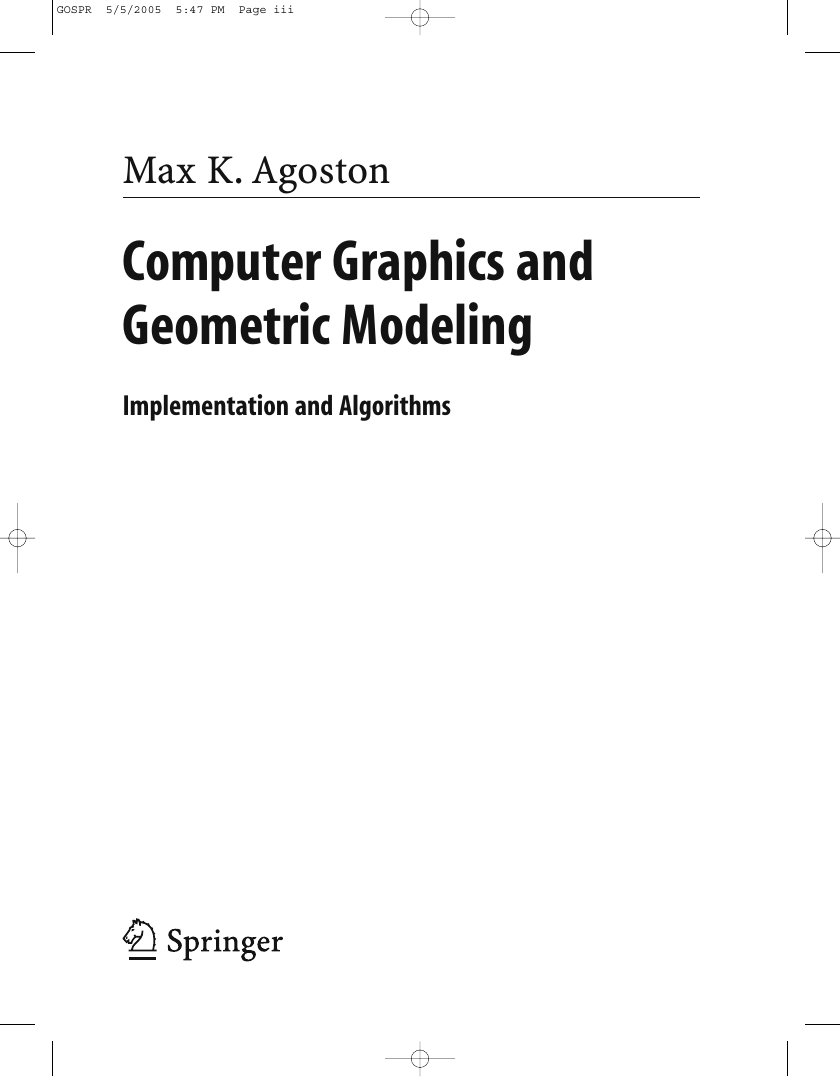
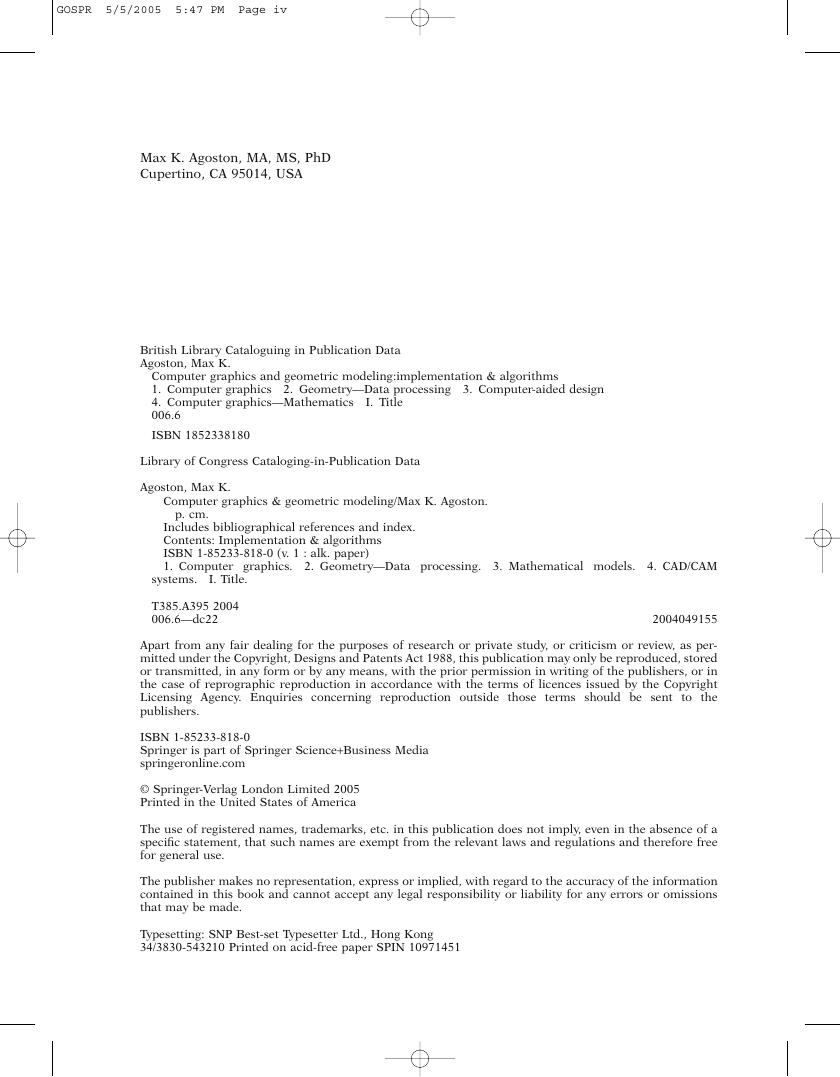
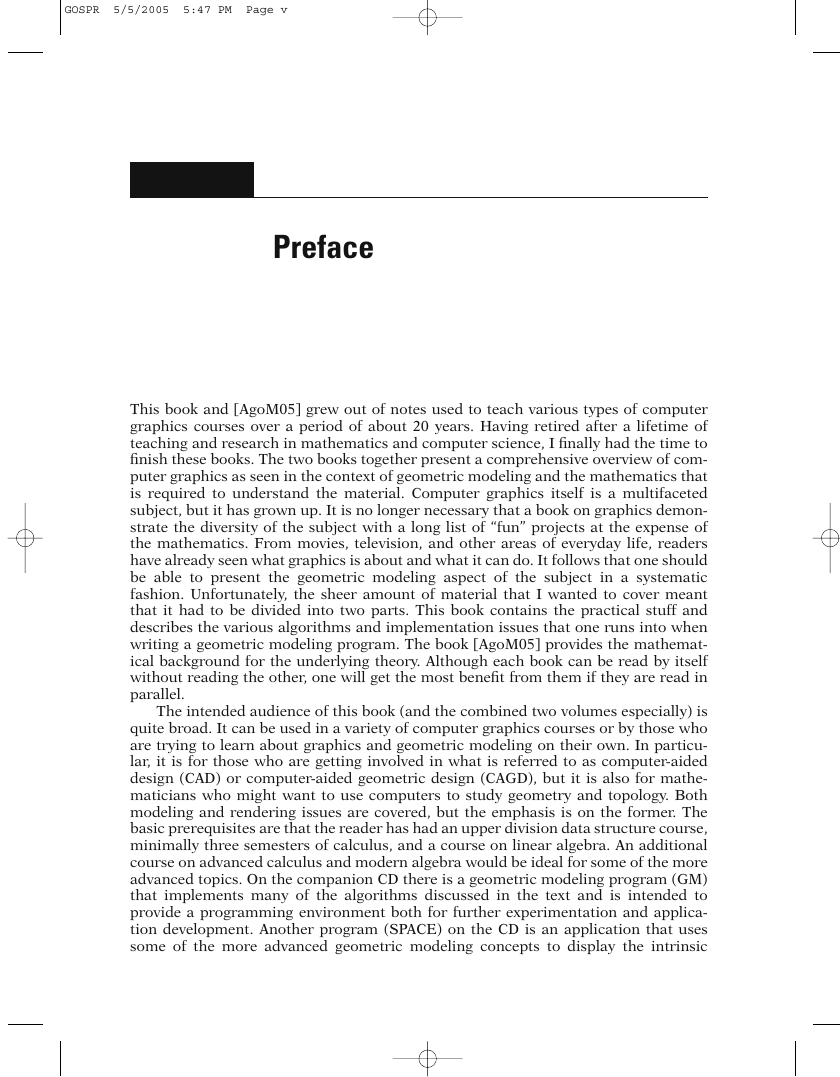

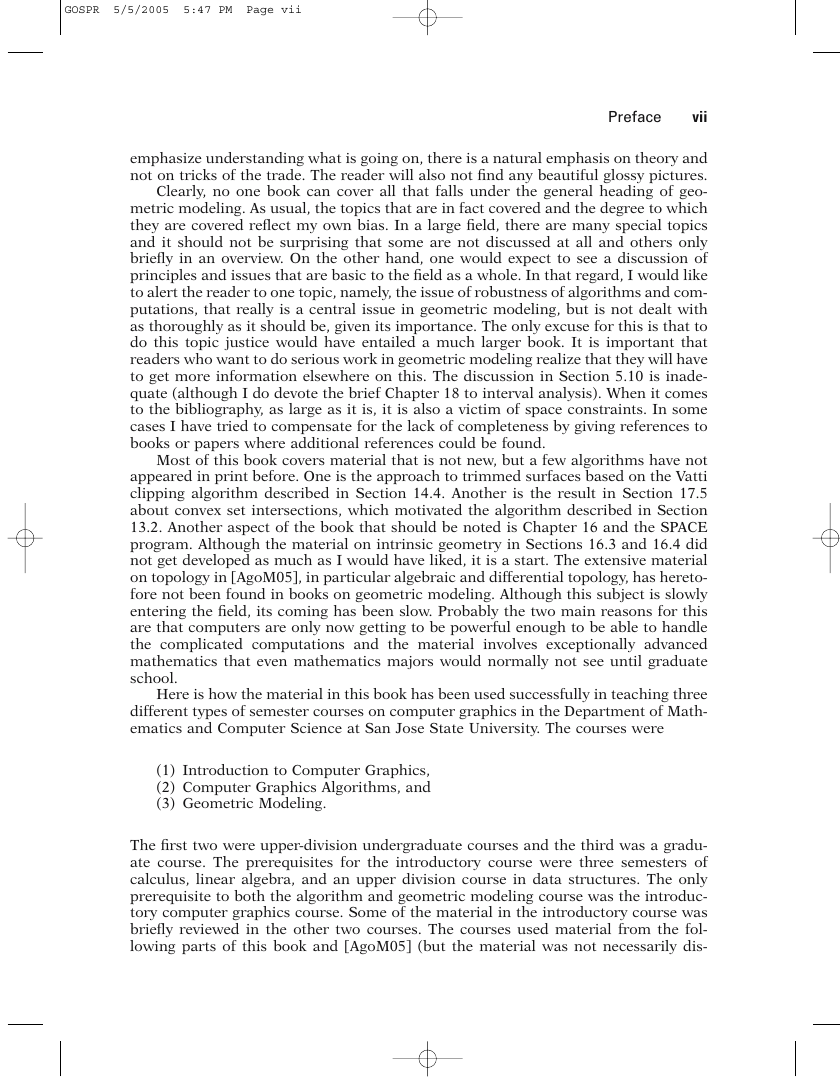
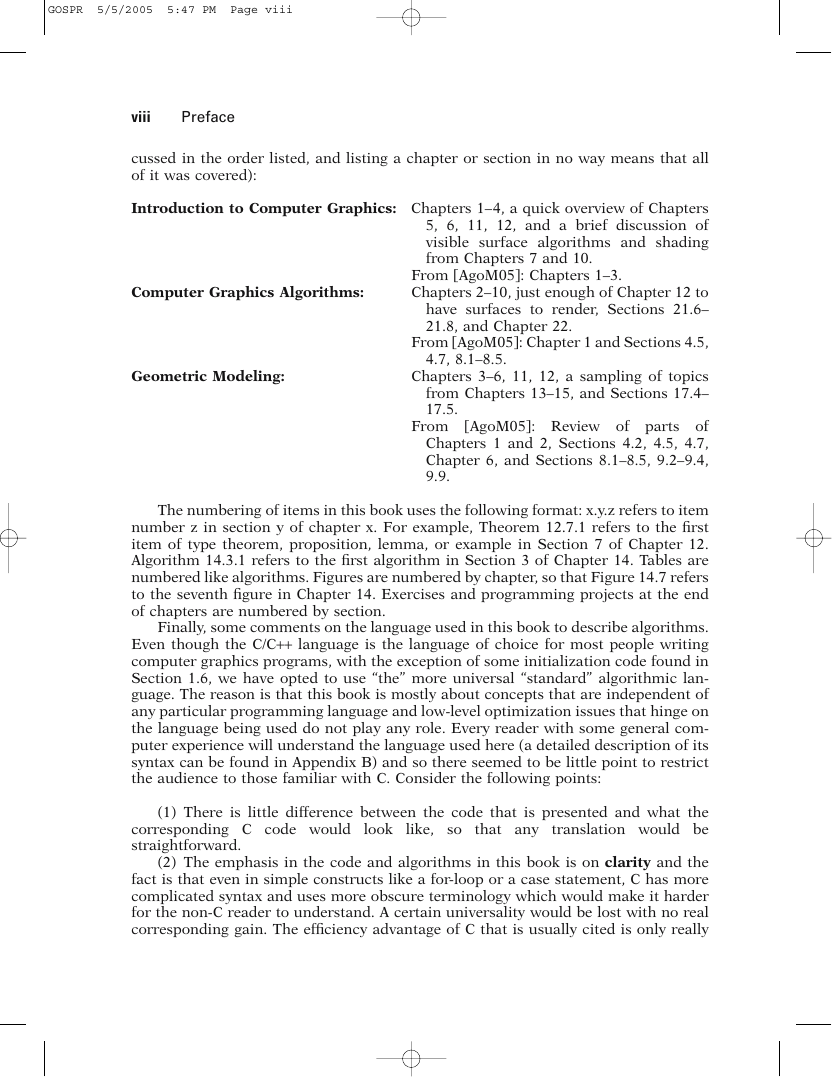
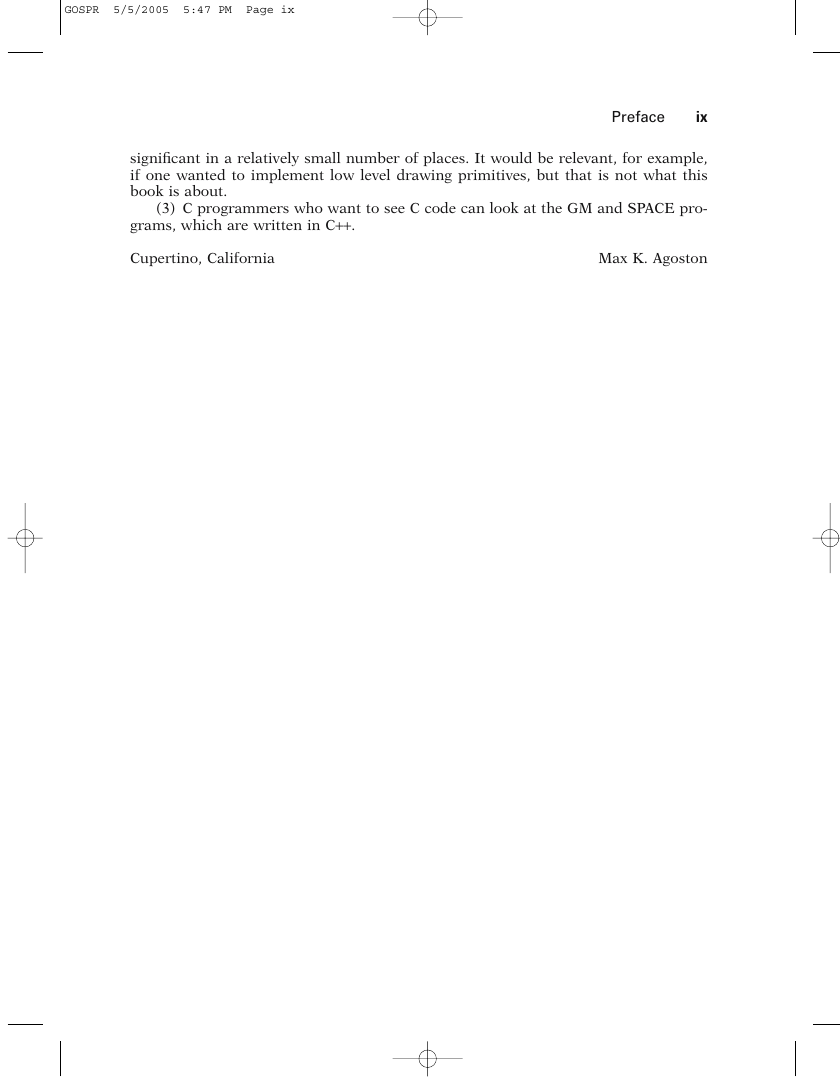








 2023年江西萍乡中考道德与法治真题及答案.doc
2023年江西萍乡中考道德与法治真题及答案.doc 2012年重庆南川中考生物真题及答案.doc
2012年重庆南川中考生物真题及答案.doc 2013年江西师范大学地理学综合及文艺理论基础考研真题.doc
2013年江西师范大学地理学综合及文艺理论基础考研真题.doc 2020年四川甘孜小升初语文真题及答案I卷.doc
2020年四川甘孜小升初语文真题及答案I卷.doc 2020年注册岩土工程师专业基础考试真题及答案.doc
2020年注册岩土工程师专业基础考试真题及答案.doc 2023-2024学年福建省厦门市九年级上学期数学月考试题及答案.doc
2023-2024学年福建省厦门市九年级上学期数学月考试题及答案.doc 2021-2022学年辽宁省沈阳市大东区九年级上学期语文期末试题及答案.doc
2021-2022学年辽宁省沈阳市大东区九年级上学期语文期末试题及答案.doc 2022-2023学年北京东城区初三第一学期物理期末试卷及答案.doc
2022-2023学年北京东城区初三第一学期物理期末试卷及答案.doc 2018上半年江西教师资格初中地理学科知识与教学能力真题及答案.doc
2018上半年江西教师资格初中地理学科知识与教学能力真题及答案.doc 2012年河北国家公务员申论考试真题及答案-省级.doc
2012年河北国家公务员申论考试真题及答案-省级.doc 2020-2021学年江苏省扬州市江都区邵樊片九年级上学期数学第一次质量检测试题及答案.doc
2020-2021学年江苏省扬州市江都区邵樊片九年级上学期数学第一次质量检测试题及答案.doc 2022下半年黑龙江教师资格证中学综合素质真题及答案.doc
2022下半年黑龙江教师资格证中学综合素质真题及答案.doc